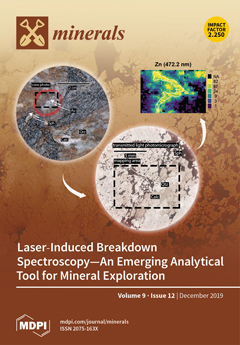The new mineral species magnanelliite, K
3Fe
3+2(SO
4)
4(OH)(H
2O)
2, was discovered in the Monte Arsiccio mine, Apuan Alps, Tuscany, Italy. It occurs as steeply terminated prisms, up to 0.5 mm in length, yellow to orange-yellow in color, with a vitreous luster. Streak is pale yellow, Mohs hardness is ca. 3, and cleavage is good on {010}, fair on {100}. The measured density is 2.82(3) g/cm
3. Magnanelliite is optically biaxial (+), with α = 1.628(2), β = 1.637(2), γ = 1.665(2) (white light), 2
Vmeas = 60(2)°, and 2
Vcalc = 59.9°. It exhibits a strong dispersion,
r >
v. The optical orientation is
Y =
b,
X ^
c ~ 25° in the obtuse angle β. It is pleochroic, with
X = orange yellow,
Y and
Z = yellow. Magnanelliite is associated with alum-(K), giacovazzoite, gypsum, jarosite, krausite, melanterite, and scordariite. Electron microprobe analyses give (wt.%): SO
3 47.82, TiO
2 0.05, Al
2O
3 0.40, Fe
2O
3 25.21, MgO 0.07, Na
2O 0.20, K
2O 21.35, H
2O
calc 6.85, total 101.95. On the basis of 19 anions per formula unit, assuming the occurrence of one (OH)
− and two H
2O groups, the empirical chemical formula of magnanelliite is (K
2.98Na
0.04)
Σ3.02(Fe
3+2.08Al
0.05Mg
0.01)
Σ2.14S
3.93O
16(OH)(H
2O)
2. The ideal end-member formula can be written as K
3Fe
3+2(SO
4)
4(OH)(H
2O)
2. Magnanelliite is monoclinic, space group
C2/
c, with
a = 7.5491(3),
b = 16.8652(6),
c = 12.1574(4) Å, β = 94.064(1)°,
V = 1543.95(10) Å
3,
Z = 4. Strongest diffraction lines of the observed X-ray powder pattern are [
d(in Å), estimated visual intensity,
hkl]: 6.9, medium, 021 and 110; 4.91, medium-weak, 022; 3.612, medium-weak,
32, 023, and
13; 3.085, strong, 202, 150, and
33; 3.006, medium, 004,
51, and 151; 2.704, medium, 152 and
23; 2.597, medium-weak,
42; 2.410, medium-weak, 153. The crystal structure of magnanelliite has been refined using X-ray single-crystal data to a final
R1 = 0.025, on the basis of 2411 reflections with
Fo > 4σ(
Fo) and 144 refined parameters. The crystal structure is isotypic with that of alcaparrosaite, K
3Ti
4+Fe
3+(SO)
4O(H
2O)
2.
Full article





